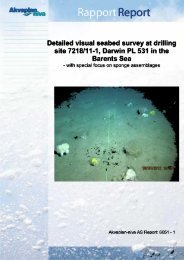A study of the priority substances of the Water Framework Directive ...
A study of the priority substances of the Water Framework Directive ...
A study of the priority substances of the Water Framework Directive ...
You also want an ePaper? Increase the reach of your titles
YUMPU automatically turns print PDFs into web optimized ePapers that Google loves.
..:::::::::: trichlorobenzene<br />
..:::74<br />
31 Trichlorobenzene<br />
� Trichlorobenzene is a group <strong>of</strong> <strong>substances</strong>.<br />
Commercial TCB was historically normally a<br />
mixture, containing mostly <strong>the</strong> 1,2,4 isomer,<br />
now purity is 99,8 %.<br />
� There is no registered use in Norway after<br />
1995.<br />
� A screening <strong>of</strong> trichlorobenzene should be<br />
done, in order to get an estimate <strong>of</strong> environmental<br />
levels and potential risks.<br />
Production and use<br />
Globally, commercial trichlorobenzene is a high<br />
volume chemical, it generally comprises <strong>of</strong> a<br />
mixture <strong>of</strong> various isomers, mainly 1,2,4- isomer<br />
(80-100 %). It has been used as intermediate<br />
in <strong>the</strong> production <strong>of</strong> herbicides, as a solvent<br />
or dye carrier, as additive to PCB and as anticorrosive<br />
agent. No emissions "<strong>of</strong> significance"<br />
are registered in Norway (Miljøstatus), about<br />
20 kilos in 2002 (SFT). A 20 % drop in emissions<br />
has been estimated since 1995.<br />
Trichlorobenzene is not registered in <strong>the</strong><br />
Norwegian Product Register after 1995, and<br />
<strong>the</strong>re is little knowledge on earlier use.<br />
Emissions, discharges,<br />
distribution and hot-spots<br />
There are too few data on trichlorobenzene in<br />
Norway to estimate emissions. The substance<br />
has a long-range transport potential.<br />
Trichlorobenzene has not been found in any<br />
studies in Norway, but it has not been possible<br />
to establish whe<strong>the</strong>r any <strong>study</strong> actually looked<br />
for <strong>the</strong> substance.<br />
Need for fur<strong>the</strong>r screening and monitoring<br />
Trichlorobenzene is probably not a problem in<br />
Norway. However, a screening should be done<br />
to establish levels in <strong>the</strong> environment.<br />
Localities for fur<strong>the</strong>r screening and monitoring<br />
Trichlorobenzene should be screened in marine<br />
and fresh water sediment and biota.<br />
Analysis<br />
The analysis <strong>of</strong> trichlorobenzenes is <strong>of</strong>ten part<br />
<strong>of</strong> packages with several o<strong>the</strong>r volatile organic<br />
compounds (VOC) or o<strong>the</strong>r chlorobenzenes.<br />
A <strong>study</strong> <strong>of</strong> <strong>the</strong> <strong>priority</strong> <strong>substances</strong> <strong>of</strong> <strong>the</strong> <strong>Water</strong> <strong>Framework</strong> <strong>Directive</strong><br />
TA-2140/2005<br />
FACTS<br />
Cas no.: 12002-48-1<br />
87-61-6 (1,2,3-trichlorobenzene)<br />
120-82-1 (1,2,4-trichlorobenzene)<br />
108-70-3 (1,3,5-trichlorobenzene)<br />
Synonyms: TCB, Trichlorobenzol, Hostetex L-PEC.<br />
Properties: Colourless liquid or crystalline, solid below<br />
17°C.<br />
Toxic effects: 1,2,4-trichlorobenzene is slightly toxic,<br />
LD50 (rat oral) is 756 mg/kg. TCB is also an irritant, and<br />
it is very toxic to aquatic organisms (LC50 rainbow<br />
trout (Oncorhynchus mykiss) is 1,95 mg/l/48 hour).<br />
Log Kow: 3,93 - 4,2<br />
Persistence: 1,2,4-trichlorobenzene has an atmospheric<br />
half-life <strong>of</strong> 30 days and half life ranging from<br />
several weeks to a few months in soil and water.<br />
Bioaccumulation in aquatic life forms is high.<br />
<strong>Water</strong> solubility: 48-100 mg/l<br />
Molecular formula: C 6 H 3 Cl 3<br />
Metabolites: Dichlorobenzenes, monochlorobenzene<br />
via chlorinated phenols and catechols.<br />
Methods<br />
The methods are based on purge-and-trap, or<br />
head-space analysis, or based on direct extraction<br />
with an organic solvent (sediment and<br />
biota) or solid phase extraction (SPE), chromatographic<br />
clean-up and separation and quantification<br />
with GC-based methods: GC/MS or<br />
GC/ECD.<br />
Synergy with o<strong>the</strong>r analyses<br />
Sample preparation and quantification can be<br />
co-ordinated with <strong>the</strong> analysis <strong>of</strong> o<strong>the</strong>r VOC<br />
like compounds or o<strong>the</strong>r chlorobenzenes.<br />
References<br />
� HSDB: Trichlorobenzene.<br />
� Miljøstatus: TCB.<br />
� ClassLab, Trichlorobenzene.<br />
� CIRCA, Royal Haskoning Fact sheets on production,<br />
use and release <strong>of</strong> <strong>priority</strong> <strong>substances</strong> in<br />
<strong>the</strong> WFD, Pentachlorophenol, Final version 31<br />
January 2001<br />
� SFT TCB 1995-2002.<br />
� US EPA: Consumer Factsheet on 1,2,4trichlorobenzene.

















